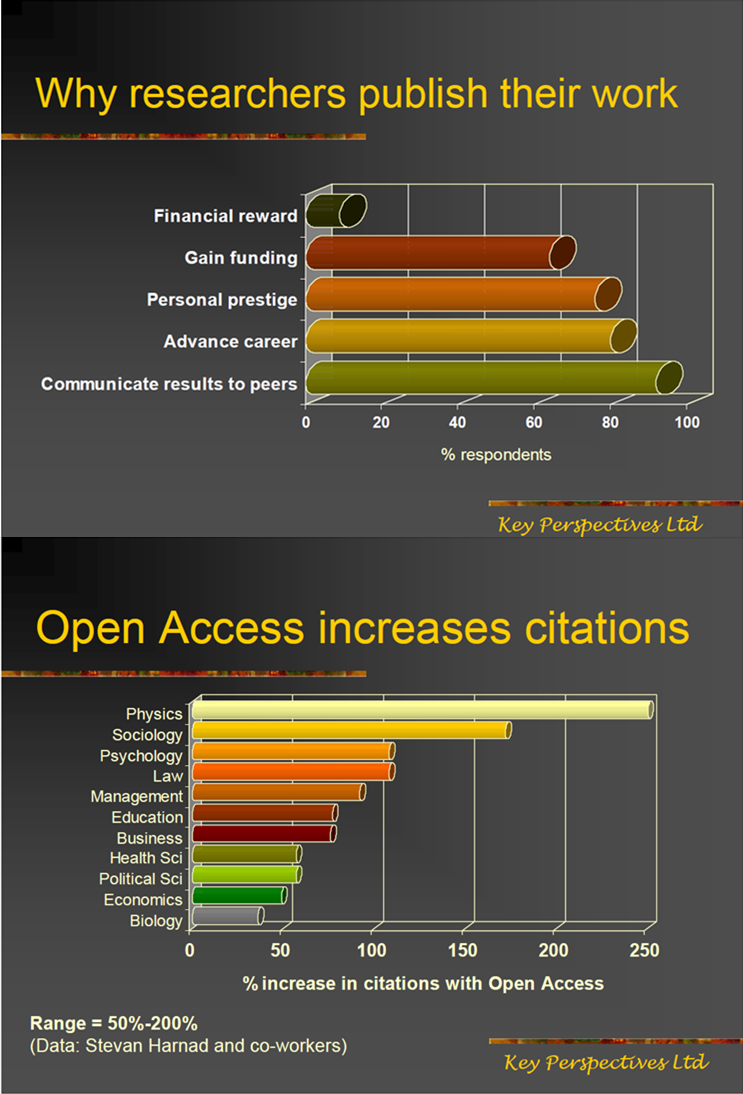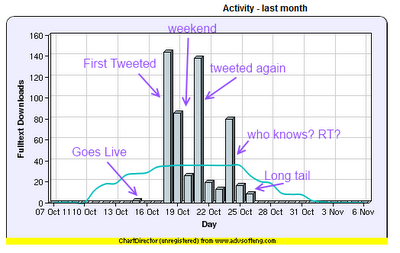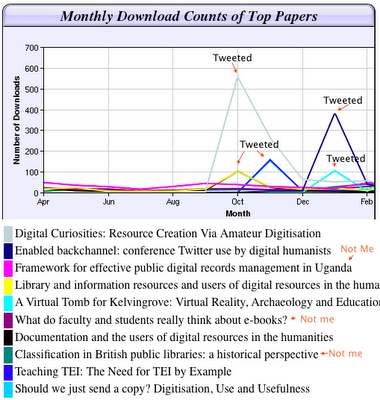Publishing in an Open Access Journal
| Site: | QMplus - The Online Learning Environment of Queen Mary University of London |
| Module: | RDF: Principles of Open Access and Open Access Publishing |
| Book: | Publishing in an Open Access Journal |
| Printed by: | Guest user |
| Date: | Thursday, 6 November 2025, 10:41 PM |
Description
Publishing in an Open Access Journal
Table of contents
- 1. Introduction to Publishing in an Open Access Journal
- 2. Finding Information on Journal/Publisher Open Access Policies and Tools to Support Researchers
- 3. High Impact Journals and Open Access Uptake
- 4. Preparing a Paper for Submission to a Journal: Versions and Open Access Routes
- 5. Submitting a Paper for Publication: Gold and Green
- 6. After the Paper is Accepted: What to Do?
1. Introduction to Publishing in an Open Access Journal
This section covers guidance on publishing a paper in Open Access publications. The method of delivery is in text and presentation format.
On completion of this section, you will have awareness of the Open Access publication process and compliant publications.
|
Thinking points
|
2. Finding Information on Journal/Publisher Open Access Policies and Tools to Support Researchers
There are tools to help researchers with finding Open Access compliant publications. Find out more about them in the screen below (access the text version by following this link).
3. High Impact Journals and Open Access Uptake
There are various journal ranking metrics (Eigenfactor, SJR, SNIP, etc.) to measure or describe the importance of a particular journal to its field. The Impact Factor, as devised by Thomas Reuters in the 60s, is one of these metrics. It is a measure of the frequency with which the average article (not individual articles) published in a given scholarly journal (indexed by Thomas Reuters) has been cited in a particular year or period. Journals with higher impact factors are deemed to be more important than those with lower ones, and this measurement is widely used in scholarly circles in the evaluation of an academic journal's reputation and quality, even if the journal is not an Open Access publication.
However, the process of journal ranking is not a perfect one as it generally does not reflect the citation counts of an individual paper but the citation counts of an average article in the journal. It works towards promoting the reputation of the journal rather than the paper. In a report published back in 2004, the House of Commons Science and Technology Select Committee recognised this and urged the Higher Education Funding Council for England to remind Research Assessment Exercise panels to change their attitude:
The perception that the RAE rewards publication in journals with high impact factors is affecting decisions made by authors about where to publish. We urge HEFCE to remind RAE panels that they are obliged to assess the quality of the content of individual articles, not the reputation of the journal in which they are published. [Select Committee on Science and Technology Tenth Report 2004, Section 9 - Integrity of the publishing process, paragraph 210]
The report states that journal impact factors taken as an indication of the quality of the articles in those journals cause a bias amongst UK authors towards journals with higher impact factors. This in turn increases the journal's impact factor still further, which in turn supports a hierarchy of journals, making it difficult for new Open Access journals to compete.
This was nearly a decade ago. Today there are many reputable Open Access publishers and platforms that researchers can choose from, and individual article citations are gaining weight as opposed to journal ranking. In addition to this, it is anticipated that the Research Excellence Framework (REF) 2020, which assesses the quality of research done in UK higher education institutions, will require all research outputs to be Open Access compliant. Therefore, researchers need to have more confidence in their research output and start investigating alternative publications that offer Open Access to their papers if their preferred journal is not Open Access compliant. There is support for this movement and evidence that the paper counts, not the journal. Read about the studies carried out in the next chapters.
3.1. Evidence Supporting Increased Citation Rates for Open Access Papers
OpCit – Reference Linking and Citation Analysis for Open Archives was a three-year research and development project completed at the end of 2002. The project was funded by the Joint NSF – JISC International Digital Libraries Research Programme, and Open Access champion Stevan Harnad was the principal investigator. One of project aims was to compile a bibliography of studies on ‘The effect of open access and downloads ('hits') on citation impact'. One of the participants in the project, another Open Access advocate Steve Lawrence, concluded in his research carried out for OpCit that,
Free online availability facilitates access in many ways, including provision of online archives; direct connections among scientists or research groups; hassle-free links from e-mail, discussion groups and other services; indexing by web search engines; and the creation of third-party search services. Free online availability of scientific literature offers substantial benefits to science and society. To maximize impact, minimize redundancy and speed scientific progress, authors and publishers should aim to make research easy to access. [Lawrence, S., ‘Free online availability substantially increases a paper's impact’, Nature, 31 May 2001]
The top five most-cited papers (as measured by Google Scholar) from this bibliography of work studying the impact of Open Access on citation rates are listed below if you are interested in reading more on the topic:
1. Lawrence, S., ‘Free online availability substantially increases a paper's impact’, Nature, 31 May 2001. Metrics: GS, Biblio
2. Harnad, S. and Brody, T., ‘Comparing the Impact of Open Access (OA) vs. Non-OA Articles in the Same Journals’, D-Lib Magazine, Vol. 10 No. 6, June 2004. Metrics: GS, Biblio
3. Antelman, K., ‘Do Open-Access Articles Have a Greater Research Impact?’ College and Research Libraries, 65(5):372-382, September 2004. Metrics: GS, Biblio
4. Eysenbach, G., ‘Citation Advantage of Open Access Articles’, PLoS Biology, Volume 4, Issue 5, May 2006. Metrics: GS, Biblio
5. Harnad, S., et al., ‘The Access/Impact Problem and the Green and Gold Roads to Open Access: An Update’, Serials Review, Vol. 34, No. 1, March 2008, 36-40. Metrics: GS, Biblio
The overall conclusion of this research was that, free open access to articles creates higher citation rates for those papers and that free and open dissemination of research output increases the reputation of a researcher and opens channels for communication and collaboration, which benefits everyone.
Key Perspectives are consultants in scholarly communication; they have produced reports, briefings, and presentations on the impact of Open Access on scholarly communications. The slides below are taken from one of their presentations on the impact of Open Access on citation rates. The graphics show why the majority of researchers want to publish their work and how Open Access increases citation rates in different subject areas:

When researchers were asked why they published/wanted to publish their work, the majority of those who participated in the study said that they published/wanted to publish their work 'to communicate results to peers'. As studies show that Open Access to research output increases citation rates, it then follows that the most successful way of communicating results to peers is by publishing papers not necessarily in journals with high impact factors, journals that may not be Open Access, but by publishing them in an Open Access publication or platform. This makes the paper accessible to everyone and increases dissemination of research results, which is why researchers publish in the first place.
PLoS - the Public Library of Science has published many research articles which show that Open Access papers attract higher citation rates. A research paper in PLoS One, ‘Self-Selected or Mandated, Open Access Increases Citation Impact for Higher Quality Research’, is co-authored by Open Access champion Stevan Harnad. The paper includes many tables and graphics charting the impact advantage of Open Access and claims that, authors who self-archive even their own final drafts of papers to make them freely accessible have an advantage over other authors publishing in the same journal: these self-archived Open Access papers are cited significantly more than articles in the same journal. The research concludes that,
The OA advantage is greater for the more citable articles, not because of a quality bias from authors self-selecting what to make OA, but because of a quality advantage, from users self-selecting what to use and cite, freed by OA from the constraints of selective accessibility to subscribers only. It is hoped that these findings will help motivate the adoption of OA self-archiving mandates by universities, research institutions and research funders. [Harnad, S., et al. ‘Self-Selected or Mandated, Open Access Increases Citation Impact for Higher Quality Research’, PLoS ONE, 5(10), 2010]
Another research paper published in PLoS Biology on this subject is 'Citation Advantage of Open Access Articles' by Gunther Eysenbach. The author compared the impact of Open Access and non-Open Access articles from the same journal in the first 4–16 months after their publication and found out that Open Access articles are cited earlier and are, on average, cited more often than non-Open Access articles. He concludes that 'Researchers, publishers, and policymakers confronted with the question of whether or not to invest in OA publishing have reason to believe that OA accelerates scientific advancement and knowledge translation of research into practice.' [Eysenbach, G. 'Citation Advantage of Open Access Articles', PLoS Biology, 4(5), 2006.]
3.2. Social Media as a Tool for Increasing Citation Rates
One should not forget the power of social media tools today to help disseminate knowledge and information in such a speedy fashion.
Melissa Terras, the Co-Director of University College London Centre for Digital Humanities, has experimented with tweeting and blogging as a medium for disseminating information and gathering citation statistics on one of her Open Access articles. She charts her experiment in her paper ‘The Impact of Social Media on the Dissemination of Research: Results of an Experiment’. Her experiment shows, without any equivocation, that an Open Access paper which is also tweeted and blogged about gets much higher download and citation rates. The chart below represents what happened to her paper ‘Digital Curiosities: Resource Creation via Amateur Digitisation’:

This is the author's comments on what happened:
Prior to me blogging and tweeting about the paper, it was downloaded twice (not by me). The day I tweeted and blogged it, it immediately got 140 downloads. This was on a Friday; on the Saturday and Sunday it got downloaded, but by fewer people. On Monday it was retweeted and the paper received a further 140 or so downloads. I have no idea what happened on the 24th of October — someone must have linked to it? Posted it on a blog? Then there were a further 80 downloads. Then the traditional long tail, then it all goes quiet…All in all, it’s been downloaded 535 times since it went live, from all over the world...[Terras, M. 'The Impact of Social Media on the Dissemination of Research: Results of an Experiment’, The Journal of Digital Humanities, (1)3, 2012]
The author concludes that blogging and tweeting about research papers are worth it and advises researchers that, as well as making their papers Open Access, they should tweet and blog about their work. The chart below shows what happens to papers that are tweeted and blogged about as opposed to those which do not have that advantage:

According to the author, statistics show that the 'Digital Curiosities' article was the fifth most downloaded paper in the UCL repository in October 2011. Read about the full experiment here.
Gunther Eysenbach from the University of Toronto, Centre for Global eHealth Innovation also has carried out a research on social media as a tool for increasing citation rates. He has authored a work experimenting on Twitter as a medium for calculating impact factors for Open Access articles: 'Can Tweets Predict Citations? Metrics of Social Impact Based on Twitter and Correlation with Traditional Metrics of Scientific Impact'. For a given period of time, the author mined all tweets containing links to articles in the Open Access Journal of Medical Internet Research. He then calculated different metrics of social media impact and compared them against subsequent citation data from Scopus and Google Scholar. His experiment to predict the top-cited articles in each issue through tweet metrics was validated, and he concluded that,
Tweets can predict highly cited articles within the first 3 days of article publication. Social media activity either increases citations or reflects the underlying qualities of the article that also predict citations, but the true use of these metrics is to measure the distinct concept of social impact. Social impact measures based on tweets are proposed to complement traditional citation metrics. The proposed twimpact factor may be a useful and timely metric to measure uptake of research findings and to filter research findings resonating with the public in real time. [Eysenbach, G. ‘Can Tweets Predict Citations? Metrics of Social Impact Based on Twitter and Correlation with Traditional Metrics of Scientific Impact', Journal of Medical Internet Research, 13(4), December 2011]
The author uses terms ‘Tweetation’ for a citation in a tweet mentioning a journal article URL and ‘Twimpact’ for the cumulative number of tweetations 7 days after publication of the article in his paper. He counts ‘Tweetations’ to gather citation statistics for his own article. As of mid-March 2013, there have been 1175 citations since the paper's publication in December 2011 and the figure is rising. It is unlikely that a paper published in a journal which may have a high impact factor but is not Open Access could boast of similar citation rates. Read about the full experiment here.
3.3. Conclusion
One of the arguments coming from scholarly circles with respect to Open Access publishing of their research output is that researchers, in order to comply with funder mandates, will be steered towards publishing in Open Access compliant journals that do not necessarily have high impact factors. This is considered by some researchers as detrimental to their reputation, especially the reputation of their scholarly output amongst their peers worldwide. There is an assumption of decreased findability of their work and, in relation to this, falling citation rates.
However, this assumption has been disproved by studies only some of which are cited in previous chapters. The conclusions of these works are in contradiction with some scholarly arguments that the value of a researcher’s work is dependent on its being published in a journal with a ‘high impact factor’, even if the journal is not an Open Access publication.
A research paper should have its own intrinsic value regardless of the medium it is published in, and researchers should not worry about losing reputation, of not being recognised internationally for not having their work published in a so-called ‘reputable’ journal. The paper’s reputation should come before the ‘reputation’ of the publisher. The ‘reputation’ of the publisher stems from the monetary wealth of that publisher after all: its network of distribution and its power of lobbying and wooing Higher Education institutions. A researcher’s paper, on the other hand, is a product of intellectual hard work; is valuable in its own right and should be treated as such.
4. Preparing a Paper for Submission to a Journal: Versions and Open Access Routes
When you are writing a paper for publication, it is important that you keep all versions of your paper if you are to comply with your funder's Open Access mandates. Find out more about this in the screen below (access the text version by following this link).
5. Submitting a Paper for Publication: Gold and Green
Submitting a paper for publication under one of the Open Access routes requires you to go through a decision-making process. Find out more about this in the screen below (access the text version by following this link).
6. After the Paper is Accepted: What to Do?
After your paper is published, there are steps you need to take to ensure that you have complied with your funder's Open Access mandates. Find out more about this in the screen below (access the text version by following this link).
Take the Quiz or continue to the next section 'Institutional Tools for Research Publications'